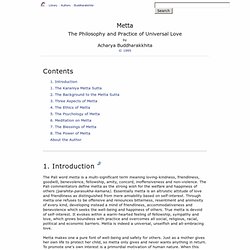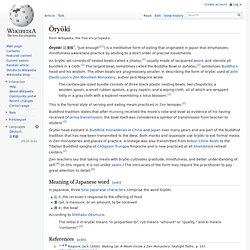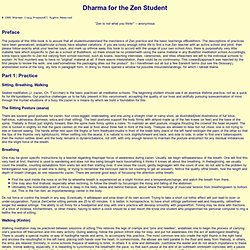

Mandala â Sacred Geometry in Buddhist Art. Perhaps the most admired and discussed symbol of Buddhist religion and art is the mandala, a word which, like guru and yoga, has become part of the English language.

Its popularity is underscored by the use of the word mandala as a synonym for sacred space in scholarship world over, and by its presence in English-language dictionaries and encyclopedias. Both broadly define mandalas as geometric designs intended to symbolize the universe, and reference is made to their use in Buddhist and Hindu practices. The mandala idea originated long ago before the idea of history itself. Metta: The Philosophy and Practice of Universal Love.
The Pali word metta is a multi-significant term meaning loving-kindness, friendliness, goodwill, benevolence, fellowship, amity, concord, inoffensiveness and non-violence.

The Pali commentators define metta as the strong wish for the welfare and happiness of others (parahita-parasukha-kamana). Essentially metta is an altruistic attitude of love and friendliness as distinguished from mere amiability based on self-interest. Through metta one refuses to be offensive and renounces bitterness, resentment and animosity of every kind, developing instead a mind of friendliness, accommodativeness and benevolence which seeks the well-being and happiness of others.
Happiness+does+not+depend+on+what+you+have+or+who+you+are.+it+solely+relies+on+what+you+think.+Buddha. Oryoki of de beoefening van “juist genoeg” - broodkruimels.be - Ōryōki. Ōryōki (応量器?

, "Just enough"[1]) is a meditative form of eating that originated in Japan that emphasizes mindfulness awareness practice by abiding to a strict order of precise movements. An ōryōki set consists of nested bowls called a jihatsu,[2] usually made of lacquered wood, and utensils all bundled in a cloth.[2] The largest bowl, sometimes called the Buddha Bowl or zuhatsu,[2] symbolizes Buddha's head and his wisdom.
The other bowls are progressively smaller. In describing the form of ōryōki used at John Daido Loori's Zen Mountain Monastery, author Jack Maguire wrote The cantaloupe-sized bundle consists of three black plastic nesting bowls, two chopsticks, a wooden spoon, a small rubber spatula, a gray napkin, and a wiping cloth, all of which are wrapped tidily in a gray cloth with a topknot resembling a lotus blossom.[1] Watch The Buddha Online. Myths & Logic Of Shaolin Monks Pt 1. Chakra-meditation-spiral.gif (GIF Image, 2217 × 3013 pixels) - Scaled (21%) Bob Thurman: We can be Buddhas. Www.zenamsterdam.nl/wp-content/uploads/zca_koanlijst.pdf. Www.zenamsterdam.nl/wp-content/uploads/zca_draaiboek_zazen.pdf.
De Drie Buigingen - Stichting Leven in Aandacht. Media. Www.zenamsterdam.nl/wp-content/uploads/zca_soetras.pdf. Hartsoetra, MAHA PRAJNA PARAMITA. Buddhist Chanting - Heart Sutra / 般若心経 / Hannya Shingyo (Japanese) 般若心経 The Heart Sutra. Www.mahakarunachan.be/wp-content/uploads/2010/12/05-Identiteit-veelheid-eenheid.pdf. How to Meditate - Guided Meditation Techniques - Buddhist Meditations. BEGINNER'S GUIDE ... © 1995 Dharman Craig PressonAll Rights Reserved “Zen is not what you think!”

-- anonymous Preface The purpose of this little book is to assure that all studentsunderstand the mechanics of Zen practice and the basic teachings ofBuddhism. The descriptions of practices have been generalized, andparticular schools have adopted variations. Part 1: Practice Sitting, Breathing, Walking Seated meditation (J. zazen, Ch. The Sitting Posture (asana) There are several good postures for zazen: four cross-legged, onekneeling, and one using a straight chair or camp stool, as illustrated[Add illustrations of full lotus, half-lotus, sukhasana, Burmese, seiza,and chair sitting]. Breathing One may be given specific instructions by a teacher regarding theproper focus of awareness during zazen. Do not force or control the breath in any way. Walking (Kinhin) Part 2: Theory The Buddha The Dharma The Four Noble Truths 1. 2. 3.
This Truth is the basis of the Buddhist system. 4. The Eightfold Noble Path. Buddhism and the God-idea. Do Buddhists believe in a god?

No, we do not. There are several reasons for this. The Buddha, like modern sociologists and psychologists, believed that religious ideas and especially the god idea have their origins in fear. The Buddha says: Gripped by fear people go to sacred mountains, sacred groves, sacred trees and shrines. Primitive humans found selves in a dangerous and hostile world, the fear of wild animals, of not being able to find enough food, of injury or disease, and of natural phenomena like thunder, lightning and volcanoes were constantly with them. The second reason the Buddha did not believe in a god is because there does not seem to be any evidence to support this idea. The third reason the Buddha did not believe in a god is that the belief is not necessary. But if there are no gods how did the universe get here? All religions have myths and stories which attempt to answer this question. What does the Buddha say about the origin of the universe?
Zen Koans - AshidaKim.com. Zen Sangha. Boeddhisme – Wat is “Zen”? Bij het horen van het woord “zen”, raken we al snel in de war.

Het is nu niet bepaald een woord dat duidelijkheid verschaft. Valt het niet een beetje samen met innerlijke vrede? Zo’n zen-tuin, dat is toch een vredige plek? Laten we eens kijken of we wat dieper in de materie kunnen duiken. Zen staat voor zenboeddhisme. De Tao Te Ching (ook wel de Dao De Jing genoemd), geschreven door Laozi (Lao Tse) begint met de zinnen “Het Tao dat genoemd wordt, is niet het eeuwige Tao”. Zen - NIET-WETEN.NL. De onmetelijke hemel hindert de witte wolken niet om te vliegen. In mijn inleiding op 23 oktober heb ik een stukje besproken uit Bukkojoji (Voorbij Boeddha gaan / Going beyond Buddha) uit Dogen’s Shobogenzo.
